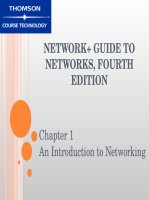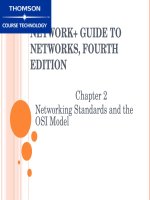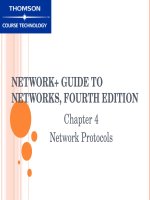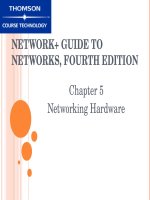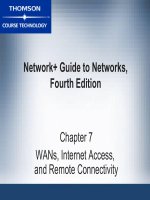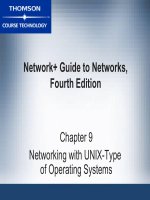NETWORK+ GUIDE TO NETWORKS, FOURTH EDITION - CHAPTER 13 pptx
Bạn đang xem bản rút gọn của tài liệu. Xem và tải ngay bản đầy đủ của tài liệu tại đây (478.28 KB, 54 trang )
Network+ Guide to Networks,
Fourth Edition
Chapter 13
Ensuring Integrity and Availability
Network+ Guide to Networks, 4e 2
Objectives
•
Identify the characteristics of a network that keeps
data safe from loss or damage
•
Protect an enterprise-wide network from viruses
•
Explain network- and system-level fault-tolerance
techniques
•
Discuss issues related to network backup and
recovery strategies
•
Describe the components of a useful disaster
recovery plan and the options for disaster
contingencies
Network+ Guide to Networks, 4e 3
What Are Integrity and Availability?
•
Integrity: soundness of network’s programs, data,
services, devices, and connections
•
Availability: how consistently and reliably file or
system can be accessed by authorized personnel
–
Need well-planned and well-configured network
–
Data backups, redundant devices, protection from
malicious intruders
•
Phenomena compromising integrity and availability:
–
Security breaches, natural disasters, malicious
intruders, power flaws, human error
Network+ Guide to Networks, 4e 4
What Are Integrity and Availability?
(continued)
•
General guidelines for protecting network:
–
Allow only network administrators to create or modify
NOS and application system files
–
Monitor network for unauthorized access or changes
–
Record authorized system changes in a change
management system
–
Install redundant components
–
Perform regular health checks
Network+ Guide to Networks, 4e 5
What Are Integrity and Availability?
(continued)
•
General guidelines for protecting network
(continued):
–
Check system performance, error logs, and system
log book regularly
–
Keep backups, boot disks, and emergency repair
disks current and available
–
Implement and enforce security and disaster
recovery policies
Network+ Guide to Networks, 4e 6
Viruses
•
Program that replicates itself with intent to infect
more computers
–
Through network connections or exchange of
external storage devices
–
Typically copied to storage device without user’s
knowledge
•
Trojan horse: program that disguises itself as
something useful but actually harms system
–
Not considered a virus
Network+ Guide to Networks, 4e 7
Types of Viruses
•
Boot sector viruses: located in boot sector of
computer’s hard disk
–
When computer boots up, virus runs in place of
computer’s normal system files
–
Removal first requires rebooting from uninfected,
write-protected disk with system files on it
•
Macro viruses: take form of macro that may be
executed as user works with a program
–
Quick to emerge and spread
–
Symptoms vary widely
Network+ Guide to Networks, 4e 8
Types of Viruses (continued)
•
File-infected viruses: attach to executable files
–
When infected executable file runs, virus copies itself
to memory
–
Can have devastating consequences
–
Symptoms may include damaged program files,
inexplicable file size increases, changed icons for
programs, strange messages, inability to run a
program
•
Worms: programs that run independently and travel
between computers and across networks
–
Not technically viruses
–
Can transport and hide viruses
Network+ Guide to Networks, 4e 9
Types of Viruses (continued)
•
Trojan horse: program that claims to do something
useful but instead harms system
•
Network viruses: propagated via network protocols,
commands, messaging programs, and data links
•
Bots: program that runs automatically, without
requiring a person to start or stop it
–
Many bots spread through Internet Relay Chat (IRC)
–
Used to damage/destroy data or system files, issue
objectionable content, further propagate virus
Network+ Guide to Networks, 4e 10
Virus Characteristics
•
Encryption: encrypted virus may thwart antivirus
program’s attempts to detect it
•
Stealth: stealth viruses disguise themselves as
legitimate programs or replace part of legitimate
program’s code with destructive code
•
Polymorphism: polymorphic viruses change
characteristics every time transferred
•
Time-dependence: time-dependent viruses
programmed to activate on particular date
Network+ Guide to Networks, 4e 11
Virus Protection: Antivirus Software
•
Antivirus software should at least:
–
Detect viruses through signature scanning
–
Detect viruses through integrity checking
–
Detect viruses by monitoring unexpected file
changes or virus-like behaviors
–
Receive regular updates and modifications from a
centralized network console
–
Consistently report only valid viruses
•
Heuristic scanning techniques attempt to identify
viruses by discovering “virus-like” behavior (may give
“false positives”)
Network+ Guide to Networks, 4e 12
Antivirus Policies
•
Provide rules for using antivirus software and
policies for installing programs, sharing files, and
using floppy disks
•
Suggestions for antivirus policy guidelines:
–
Every computer in organization equipped with virus
detection and cleaning software
–
Users should not be allowed to alter or disable
antivirus software
–
Users should know what to do in case virus detected
Network+ Guide to Networks, 4e 13
Antivirus Policies (continued)
•
Suggestions for antivirus policy guidelines
(continued):
–
Antivirus team should be appointed to focus on
maintaining antivirus measures
–
Users should be prohibited from installing any
unauthorized software on their systems
–
Systemwide alerts should be issued to network
users notifying them of serious virus threats and
advising them how to prevent infection
Network+ Guide to Networks, 4e 14
Virus Hoaxes
•
False alerts about dangerous, new virus that could
cause serious damage to systems
–
Generally an attempt to create panic
–
Should not be passed on
–
Can confirm hoaxes online
Network+ Guide to Networks, 4e 15
Fault Tolerance
•
Capacity for system to continue performing despite
unexpected hardware or software malfunction
•
Failure: deviation from specified level of system
performance for given period of time
•
Fault: involves malfunction of system component
–
Can result in a failure
•
Varying degrees
–
At highest level, system remains unaffected by even
most drastic problems
Network+ Guide to Networks, 4e 16
Environment
•
Must analyze physical environment in which
devices operate
–
e.g., excessive heat or moisture, break-ins, natural
disasters
•
Can purchase temperature and humidity monitors
–
Trip alarms if specified limits exceeded
Network+ Guide to Networks, 4e 17
Power: Power Flaws
•
Power flaws that can damage equipment:
–
Surge: momentary increase in voltage due to
lightning strikes, solar flares, or electrical problems
–
Noise: fluctuation in voltage levels caused by other
devices on network or electromagnetic interference
–
Brownout: momentary decrease in voltage; also
known as a sag
–
Blackout: complete power loss
Network+ Guide to Networks, 4e 18
UPSs (Uninterruptible Power Supplies)
•
Battery-operated power source directly attached to
one or more devices and to power supply
–
Prevents undesired features of outlet’s A/C power
from harming device or interrupting services
–
Standby UPS: provides continuous voltage to device
•
Switch to battery when power loss detected
–
Online UPS: uses power from wall outlet to
continuously charge battery, while providing power to
network device through battery
Network+ Guide to Networks, 4e 19
UPSs (continued)
•
Factors to consider when deciding on a UPS:
–
Amount of power needed
•
Power measured in volt-amps
–
Period of time to keep a device running
–
Line conditioning
–
Cost
Network+ Guide to Networks, 4e 20
Generators
Figure 13-2: UPSs and a generator in a network design
Network+ Guide to Networks, 4e 21
Topology and Connectivity
•
Key to fault tolerance in network design is
supplying multiple possible data paths
–
If one connection fails, data can be rerouted
–
On LANs, star topology and parallel backbone
provide greatest fault tolerance
–
On WANs, full mesh topology offers best fault
tolerance
–
SONET networks highly fault-tolerant
•
Redundancy in network offers advantage of
reducing risk of lost functionality and profits from
network faults
Network+ Guide to Networks, 4e 22
Topology and Connectivity (continued)
Figure 13-3: VPNs linking multiple customers
Network+ Guide to Networks, 4e 23
Topology and Connectivity (continued)
•
Automatic fail-over: use redundant components
able to immediately assume duties of an identical
component in event of failure or fault
•
Can provide some level of fault tolerance by using
hot swappable parts
•
Leasing redundant T1s allows for load balancing
–
Automatic distribution of traffic over multiple links or
processors to optimize response
Network+ Guide to Networks, 4e 24
Topology and Connectivity (continued)
Figure 13-5: Fully redundant T1 connectivity
Network+ Guide to Networks, 4e 25
Servers
•
Make servers more fault-tolerant by supplying them
with redundant components
–
NICs, processors, and hard disks
–
If one item fails, entire system won’t fail
–
Enable load balancing
